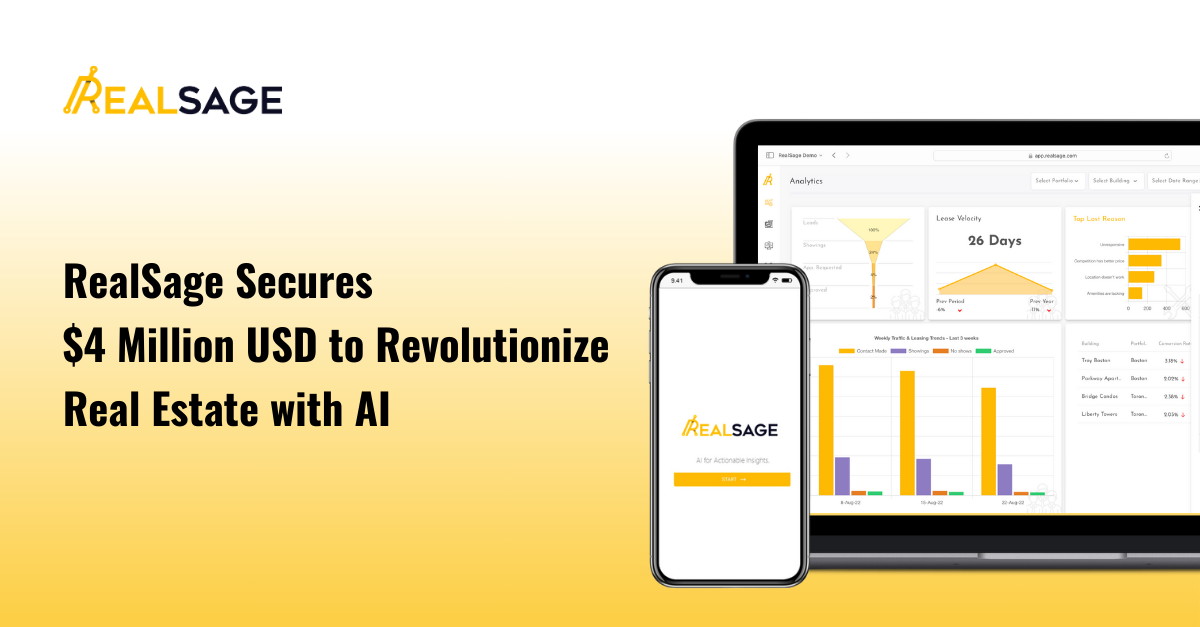Not all key performance indicators (KPIs) are created equal. Some are more important than others. As businesses continue to digitize and data becomes more accessible, here is a list of KPIs marketing teams managing large multifamily portfolios stay on top of to ensure the success of rental properties.
By leveraging data-driven insights offered by KPIs, tech firms and marketers can make more informed decisions, fine-tune their strategies, and ultimately deliver better results. The primary focus will be on the standard KPIs used across the industry, their relevance, and how you can track them.
1. Vacancy Rate:
Definition: The vacancy rate represents the percentage of properties that are vacant in a given period.
Why It Matters: This metric is a vital indicator of property demand and marketing effectiveness. It’s not just about empty spaces; it allows real estate marketing managers to fine-tune strategies, target demographics more precisely, and boost occupancy rates and revenue.
Actionable Insights:
- Analyze Vacancy Trends: Regularly review vacancy patterns to identify opportunities or challenges.
- Adjust Marketing Strategies: Tailor marketing efforts to target specific demographics that align with vacant properties.
- Monitor Competitor Rates: Keep an eye on competitor vacancy rates to understand market positioning.
- Offer Incentives: Consider special offers or incentives to attract tenants to vacant properties.
Example of Implementation: If vacancy rates are high in a particular property type, consider a targeted marketing campaign or special leasing incentives for that category.
2. Leads Generated:
Definition: Leads generated refers to the number of potential renters who have shown interest in a property, typically by contacting the company or filling out a form.
Why It Matters: This KPI measures campaign success and audience engagement. It’s not just about counting inquiries; it guides marketing tactics and resource allocation for optimized conversions and enhanced tenant acquisition.
Actionable Insights:
- Regularly Review Lead Sources: Understand where leads are coming from and invest in channels that generate quality leads.
- Segment Leads: Categorize leads by source, interest level, or other factors to tailor follow-up strategies.
- Test Different Channels: Experiment with various marketing channels to identify the most effective ones.
- Collaborate with Sales: Ensure that leads are promptly and effectively followed up on.
Example of Implementation: If a particular social media platform is generating high-quality leads, consider increasing investment in advertising on that platform.
3. Cost Per Lead (CPL):
Definition: CPL is the total marketing spend divided by the number of leads generated, evaluating the efficiency of different marketing campaigns.
Why It Matters: Reflecting marketing efficiency and budget allocation, CPL informs budget planning, enables ROI assessment, and empowers managers to optimize cost-effective lead generation approaches.
Actionable Insights:
- Compare CPL Across Channels: Identify which channels are delivering the best value and reallocate the budget accordingly.
- Monitor Over Time: Track CPL trends over time to identify opportunities for optimization.
- Align with Conversion Rates: Consider CPL in conjunction with conversion rates to understand the full value of leads from different channels.
- Experiment with Targeting: Test different targeting strategies to find the most cost-effective approach.
Example of Implementation: If CPL is high for paid search but conversion rates are also high, it may still be a valuable channel. Conversely, if CPL is low but leads are not converting, it may be worth reassessing that channel.
4. Conversion Rate:
Definition: The conversion rate is the percentage of leads that end up signing a lease.
Why It Matters: This KPI illustrates the success of lead-to-tenant transitions. It’s not just about conversions; it helps managers refine campaigns, messaging, and collaboration between marketing and sales to drive better leasing outcomes.
Actionable Insights:
- Collaborate Between Marketing and Sales: Work closely to ensure that messaging and follow-up strategies are aligned.
- Analyze Conversion Paths: Understand the typical paths that successful conversions take through the marketing funnel.
- Test Different Offers: Experiment with different offers or incentives to see what resonates best with leads.
- Monitor Competitor Strategies: Keep an eye on competitor conversion strategies that may be influencing market behavior.
Example of Implementation: If conversion rates are low from a particular lead source, consider refining the messaging or offer for that channel.
5. Tenant Retention Rate:
Definition: The tenant retention rate is the percentage of tenants renewing their leases.
Why It Matters: Reflecting tenant satisfaction and loyalty, this rate guides strategies to improve experiences, reduce turnover costs, and ensure sustained occupancy and revenue.
Actionable Insights:
- Implement Feedback Loops: Regularly solicit and act on tenant feedback to enhance their experience.
- Offer Renewal Incentives: Consider special incentives for renewing tenants.
- Monitor Market Trends: Understand market conditions that may influence renewal decisions.
- Build Community Engagement: Foster a sense of community through events or communication that may encourage renewals.
Example of Implementation: If retention rates are declining, consider a tenant survey to identify areas for improvement and act on that feedback.
6. Customer Acquisition Cost (CAC):
Definition: CAC is the total cost of sales and marketing efforts required to acquire a new customer.
Why It Matters: By measuring the cost of obtaining new tenants, CAC informs efficient marketing strategies, budget allocation, and profitability, ensuring minimized expenses for tenant acquisition.
Actionable Insights:
- Analyze CAC in Relation to LTV: Ensure that the cost of acquiring a customer is justified by their lifetime value.
- Monitor Over Time: Track CAC trends to identify changes in market cost dynamics.
- Segment by Channel: Understand which channels are most cost-effective for customer acquisition.
- Align with Organizational Goals: Ensure that CAC targets align with broader business profitability and growth goals.
Example of Implementation: If CAC is rising in a particular channel without a corresponding increase in customer value, consider reallocating resources to more cost-effective channels.
7. Net Promoter Score (NPS):
Definition: The Net Promoter Score (NPS) is a measure of tenants’ willingness to recommend the rental property to others.
Why It Matters: NPS is a vital gauge of tenant satisfaction. It’s not just about scoring; it helps marketing managers understand what steps to take to enhance property reputation and attract new tenants, reflecting the overall perception of the property.
Actionable Insights:
- Regular Surveys: Conduct regular NPS surveys to gauge tenant satisfaction and identify areas for improvement.
- Act on Feedback: Implement changes based on tenant feedback to enhance their experience.
- Segment Analysis: Analyze NPS by different tenant segments to understand specific needs and preferences.
- Track Over Time: Monitor NPS trends over time to measure the impact of changes and identify emerging issues.
Example of Implementation: If NPS reveals dissatisfaction with maintenance services, consider improving response times and communication around maintenance requests.
8. Lease Velocity:
Definition: Lease velocity refers to the length of time a unit is unoccupied between leases.
Why It Matters: This KPI indicates leasing speed and efficiency. It’s not just about tracking time; it informs marketing approaches, pricing strategies, and outreach efforts, accelerating property occupancy for quicker revenue generation and improved property performance.
Actionable Insights:
- Monitor Regularly: Keep a close eye on lease velocity to identify trends or anomalies.
- Adjust Pricing Strategies: Experiment with pricing or incentives to reduce unoccupied time.
- Analyze Market Trends: Understand market demands and align leasing strategies accordingly.
- Collaborate with Sales: Work closely with leasing agents to ensure that marketing efforts translate into quicker leasing.
Example of Implementation: If lease velocity is slow during a particular season, consider offering limited-time incentives to attract tenants more quickly.
9. Website Traffic:
Definition: Website traffic measures the level of online engagement and reach for the property.
Why It Matters: This KPI allows real estate marketing managers to assess the effectiveness of their online presence. It’s not just about counting visits; it helps identify popular property listings, customize content, and attract more potential tenants, reflecting the property’s online appeal.
Actionable Insights:
- Utilize Analytics: Use web analytics tools to identify popular listings and visitor behavior.
- Customize Content: Tailor content to match visitor interests, enhancing engagement.
- Optimize for Search Engines: Implement SEO best practices to increase organic traffic.
- Monitor User Experience: Ensure that the website is user-friendly and responsive to keep visitors engaged.
Example of Implementation: If analytics reveal that virtual tours are highly viewed, consider creating more virtual content for other property listings.
10. Website Bounce Rate:
Definition: The website bounce rate indicates the percentage of visitors leaving the site after viewing just one page.
Why It Matters: This KPI is essential for understanding visitor engagement and guiding website optimization efforts. It’s not just about tracking exits; it’s about ensuring a positive user experience, maintaining visitor engagement, and improving lead conversion rates.
Actionable Insights:
- Analyze Bounce Causes: Identify the pages with high bounce rates and analyze potential causes, such as slow loading times or irrelevant content.
- Improve Navigation: Enhance site navigation to guide visitors to relevant content, keeping them engaged.
- A/B Testing: Experiment with different layouts, calls to action, or content types to see what resonates best with visitors.
- Mobile Optimization: Ensure that the website is mobile-friendly, as a significant portion of traffic may come from mobile devices.
Example of Implementation: If a specific landing page has a high bounce rate, consider redesigning it with clearer calls to action and more engaging visuals.
11. Cost Per Impression (CPI):
Definition: The cost per impression (CPI) metric calculates the cost of displaying an ad to users.
Why It Matters: CPI is crucial for making budget decisions in advertising. It helps in maximizing ad exposure while minimizing costs, enhancing branding efforts, and ensuring that advertising spend is efficient.
Actionable Insights:
- Monitor Regularly: Keep a close eye on CPI across different channels and campaigns to identify trends or anomalies.
- Adjust Ad Placements: Experiment with different ad placements and formats to find the most cost-effective options.
- Targeting Optimization: Refine targeting parameters to reach the most relevant audience, potentially lowering CPI.
- Evaluate Ad Performance: Regularly assess how impressions are translating into clicks and conversions to ensure that low CPI aligns with overall campaign goals.
Example of Implementation: If a particular ad placement is showing a high CPI without corresponding engagement, consider reallocating the budget to more effective channels.
12. Tenant Referral Percentage:
Definition: The tenant referral percentage measures the proportion of new tenants referred by current tenants.
Why It Matters: This KPI highlights the success of tenant referral programs and indicates tenant satisfaction. It’s not just about tracking referrals; it’s about encouraging valuable word-of-mouth growth and fostering a sense of community and trust.
Actionable Insights:
- Promote Referral Programs: Actively promote referral programs to tenants through various communication channels.
- Reward Referrals: Implement a reward system for successful referrals, incentivizing tenants to participate.
- Gather Feedback: Regularly solicit feedback from tenants about the referral process and make necessary improvements.
- Track Referral Sources: Understand where referrals are coming from and tailor marketing efforts accordingly.
Example of Implementation: If tenant referrals are low, consider launching a special campaign highlighting the benefits of referring friends, along with an attractive incentive for successful referrals.
13. Lead Velocity Rate:
Definition: The lead velocity rate measures the growth rate of generated leads over time.
Why It Matters: This KPI is crucial for real estate marketing managers as it provides valuable insights into emerging tenant acquisition trends. It’s not just about tracking numbers; it’s about understanding the dynamics of the market and allowing marketing managers to adapt strategies in response to evolving demands. It serves as an early warning system for shifts in market behavior, enabling proactive adjustments.
Actionable Insights:
- Monitor Regularly: Conduct weekly or monthly reviews of the lead velocity rate to identify sudden changes or trends.
- Segment Analysis: Break down the lead velocity rate by different channels or demographics to understand where growth is coming from.
- Invest in Trending Channels: If certain marketing channels are showing a rapid increase in leads, consider allocating more resources to them.
- Collaborate with Sales: Work closely with sales teams to ensure that increased leads are translating into conversions.
- Utilize Analytics Tools: Implement lead tracking and analytics tools that provide real-time insights into lead velocity, enabling quicker responses to market changes.
- Test and Learn: Experiment with new marketing tactics and measure how they affect lead velocity, fostering a culture of continuous improvement.
Example of Implementation: If the lead velocity rate from social media advertising is consistently growing, consider creating more targeted campaigns on those platforms. Conversely, if email marketing shows a decline in lead velocity, it might be time to reassess the content and targeting strategies.
14. Content Sharing Rate:
Definition: The content sharing rate measures the frequency of property content being shared across platforms.
Why It Matters: This KPI is essential for real estate marketing managers as it helps identify content that resonates with audiences. It’s not merely about tracking shares; it’s about understanding what drives increased brand visibility, greater lead generation, and broader audience exposure. It reflects the effectiveness of content in engaging the audience and spreading the brand message.
Actionable Insights:
- Analyze Content Performance: Regularly review which types of content are being shared most frequently and why, to inform future content creation.
- Encourage Sharing: Implement sharing incentives or create easily shareable snippets to motivate users to spread the content.
- Collaborate with Influencers: Partner with industry influencers to amplify content reach.
- Utilize Social Media Tools: Consider using social media management tools that provide insights into sharing metrics, enabling more targeted content strategies.
- Create Shareable Content: Focus on creating content that provides value, engages the audience, and encourages sharing, such as infographics, videos, or insightful articles.
Example of Implementation: If a particular blog post about “Top Amenities in Modern Apartments” is being shared widely, consider creating a series of related content or a video tour showcasing those amenities. Conversely, if certain content types are not being shared, reassess their relevance and quality.
15. Marketing Contribution Margin:
Definition: The marketing contribution margin is a metric that assesses the impact of marketing efforts on overall revenue.
Why It Matters: This KPI is vital for real estate marketing managers as it helps in demonstrating the return on investment (ROI) of marketing activities. It’s not just about measuring success; it’s about understanding how marketing contributes to property profitability, optimizing resource allocation, and justifying marketing expenses.
Actionable Insights:
- Regular Review: Conduct monthly or quarterly reviews of the contribution margin to identify trends and areas for improvement.
- Align with Other Metrics: Compare the marketing contribution margin with other KPIs like Customer Acquisition Cost (CAC) and Lifetime Value (LTV) to get a holistic view of marketing efficiency.
- Invest in High-Performing Channels: Analyze which marketing channels are contributing most to the margin and allocate more resources to them.
- Collaborate with Sales: Work closely with sales teams to ensure that marketing efforts are translating into actual revenue.
- Utilize Technology: Consider implementing marketing analytics tools that provide real-time insights into the contribution margin, enabling more agile decision-making.
Example of Implementation: If the contribution margin from social media campaigns is consistently high, consider increasing investment in those channels. Conversely, if traditional advertising shows a low contribution margin, it might be time to reassess or reduce spending in that area.
Conclusion
The KPIs outlined above are more than mere numbers; they are strategic tools that can transform marketing efforts. By understanding, monitoring, and acting on these metrics, real estate marketing managers can create a roadmap to success, aligning with organizational goals and continuously improving strategies for growth.









